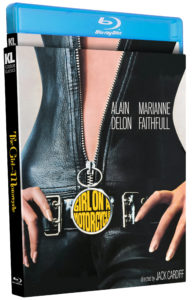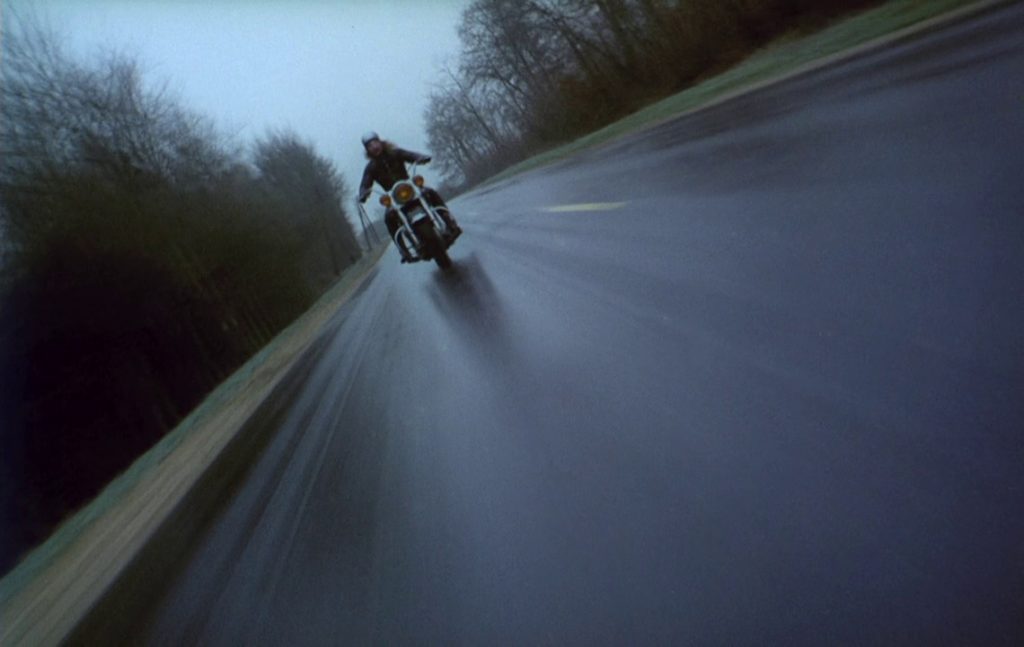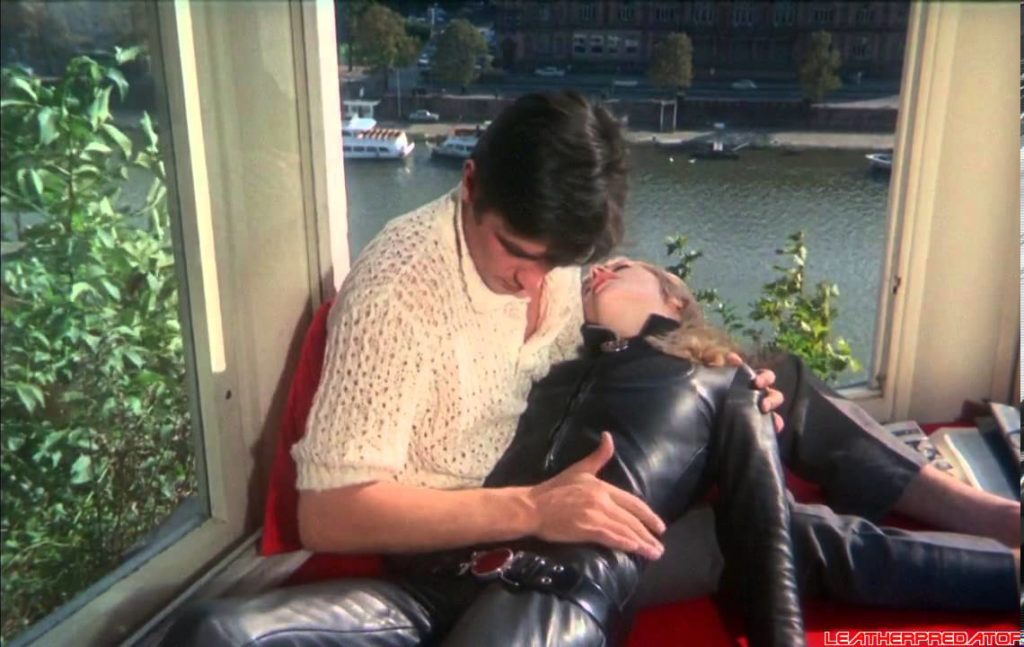Marianne Faithfull’s Counterculture Odyssey on two Wheels
DIRECTED BY JACK CARDIFF/1968
BLU-RAY STREET DATE: DECEMBER 13, 2022/KL STUDIO CLASSICS

“She’s always naked under leather”. It had to be circa 1984 when, at a grocery store in Potosi, Missouri, a rather young me noticed a VHS rental copy of this film sporting that tagline. Admittedly, Girl on a Motorcycle became and remained a curiosity ever since. After all these years, that curiosity is satisfied via a beautiful new Blu-ray edition from KL Studio Classics brandishing a fresh 4K restoration.
So… did this very noticeable Easy Rider precursor get my motor runnin’? No, not in that way- though it did hold my interest as a hippie-era remnant that strangely blends vibrant swaths of brilliant color and Old Country dullness. Zipping along all alone through ever-present Euro-fog, director and celebrated cinematographer Jack Cardiff- a master of big screen color going back at least to his photography in 1948’s The Red Shoes– finds a new and trendy way to keep the screen popping with the then-novel technique of solarization. No longer cutting edge, the abrupt shifts to isolated extreme psychedelic colors now reads as, well, rather hippie-dippy. Keeping things dynamic, however, is obviously forefront for Cardiff in adapting André Pieyre de Mandiargues’ heavily internal-monologued book, La Motocyclette. Look no further than the film’s cool opening titles. The bright, yellow-lettered names come at us and SWITCH off! at the last second. Despite the order of names, French superstar Alain Delon is not the lead. That honor goes to singer Marianne Faithfull, who portrays the titular girl, Rebecca.
A British import, Girl on a Motorcycle was the first film to be given an X rating in the U.S. Like the similarly notable Midnight Cowboy (1969), it would later be given an R rating, though re-edited and released under the ironically more salacious title Naked Under Leather. In its time, however, it’s hard to argue that the MPAA’s X was an overreaction. Still, while director Jack Cardiff lamented any censoring and the retitling of Girl on a Motorcycle, “Naked Under Leather” is an altogether accurate descriptor of Faithfull’s wardrobe for the entire film. With only a little helmet and her black leather catsuit (a real fashion influence in its time) with a red bejeweled front zipper ring, the oft teary-eyed Rebecca takes to the foggy road, her audible (often irritating, truth be told) thoughts going and going.

Though torn between her frustrated love for her malleable-as-mush husband (Roger Mutton) and her distanced lover (cool cat loner Delon), Rebecca’s most interesting relationship is with her bike. The sexual symbiosis between the girl and motorcycle is repeatedly iterated in bodily-fragmenting close-ups of Faithfull’s leather-clad anatomy straddling the seat, pleasuring the handle grip, et cetra as the machine constantly rumbles between her legs. Early on, a lusty station attendant unmistakably penetrates the tank with a gas pump. Her crotch is mere inches beyond that action in the framing of said shot. While this kind of thing is precisely what Nina Menkes, in her 2022 lecture film Brainwashed: Sex-Camera-Power, effectively calls out as dehumanizing of women, Rebecca’s individual humanity survives intact. In fact, it’s not a stretch to read the character as a complex female lead. Her obvious sexualization is by measures clunky, laddy, embarrassing, and, well, rather flattering of Faithfull, who is said to have had zero qualms about showing off her body. One of the official taglines clearly took pleasure in playing up the film’s eroticism: “More… More… More… More… She asked of her bike what she asked of the man… Her hair blowing wild… Her mouth swallowing the wind hard…”
Faithfull clearly does a lot of her own riding, except for when dangerous action is involved. Delon, however, obviously does no real riding whatsoever. All his motorcycle scenes are gaudy process shots. (Faithful did have a riding double for distant shots, a championship rider named Bill Ivy). In true late-‘60s biker film fashion, the entire film is Rebecca’s existential trek, bonding with and dominating the road. In this case, she’s leaving her husband in France to go see Delon in Germany, her memories and imagination taking us on uncertain detours throughout. While Faithfull’s film career continues to accrue milage, Girl on a Motorcycle was an early effort… which at times is apparent. While she is not bad by any stretch, she lacks brewing gravitas that might’ve put this material over the line into greatness. As it is, Cardiff and company would have to settle for “cult classic”.

No unzipping is required to reveal the KL Studio Classics’ Blu-ray’s small sidecar’s worth of bonus features. Besides the film’s trailer and assorted others, there’s a double dose of audio commentary tracks. The first is a quite old one with the late director, Jack Cardiff. Cardiff stays quiet for minutes at a time, arbitrarily interjecting his mostly sharp memories of the film, reserved as any proper Brit of a certain age. A particular favorite point of discussion of his is the film’s pioneering use of solarization, used here to further its countercultural qualities and to obscure love scenes. KL’s Blu-ray rolls out a brand new 4K restoration, stunningly showcasing the merging of drab atmosphere and imposed and noticed bright colors, beautifully and artistically shot by Cardiff himself. The argument could be made that Cardiff’s cinematography credit on Girl supersedes his directorial credit in terms of his skills sets affecting this project. The jury may forever be out on whether he was good with actors, but any studied cinephile knows he was one of the screen’s great masters when it came to capturing images. Except for those icky process shots, Girl on a Motorcycle does not sputter out in that area.
The other commentary track is a new one by film historian Alexandra Heller-Nicholas. Heller-Nicholas is interested in the intersection of genre/exploitation films and gender studies. Subsequently, Girl on a Motorcycle is one of her own personal top films. Big kudos to her for going her own way with her track rather than trafficking in all the usual commentary hoop-jumping. This is not at all a commentary about filmographies, location factoids, or dreaded story narration. Instead, Heller-Nicholas activity pursues her stated angle, quoting others and digging into notions of second-wave feminism and how Girl on a Motorcycle might fit into that then-contemporary movement and also fly in the face of it. It’s all well stated and interesting. The problem is that there isn’t enough of it. The commentary has too much dead air in between statements. It’s almost as though Heller-Nicholas repurposed an existing lecture she’s given in the past, and then realized it’s not enough material. What’s there, though, is terrifically worthwhile.
Unlike Rebecca’s wardrobe, there are layers to her internal struggles and frustrations. Torn between a man who might love her too much and a man who doesn’t love her at all, she knows that crossing international borders to maintain both can’t remain an option. Yet in her free-loving soul, she also seems to know that strictly speaking, it’s not the polyamory that’s got her down, it’s the extremes of the men themselves. This being 1968, there can’t help but be a looming fatalism over everything, anyway. She even makes a plan to leave her most intimate partner, her motorcycle, for a train. But will she need to? After all, Faithfull may be Rebecca, but Rebecca is anything but faithful. Just how long can she last going that fast?

